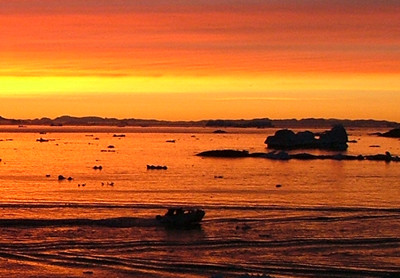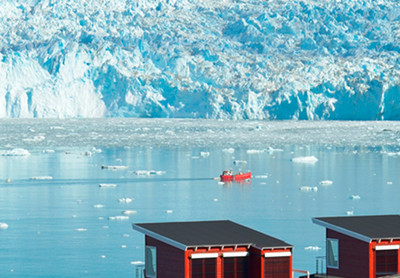Icebergs
When talking about Greenland, it’s impossible to forget the fantastic icebergs. Each with its own unique form and special beauty. Approx. 1/8th of an iceberg can be seen above the water line.
Icebergs can be seen from your doorstep in almost all Greenlandic towns and settlements.
Ilulissat Icefjord is renowned for icebergs, having the largest concentration of icebergs in Greenland. There are five types of icebergs: White icebergs are relatively young; blue ice is older, transparent black ice which is feared because it’s difficult to see; ice floes consisting of frozen sea water; and lastly, dirty ice containing accumulated sediment.
.jpg)
2 Types of Ice
There are two types of ice in Greenland: Fresh water icebergs which calve from glaciers, and salt water ice which is formed when drifting ice floes are compressed together.
When big icebergs calve even the locals take note. As large pieces of ice break off, the shock wave travels through the water like a tsunami. The sound can be deafening.
.jpg)
Sermeq Kujalleq
Sermeq Kujalleq is a glacier fed by the Greenland ice cap. It sends an average of approx. 70 million tons of ice through Ilulissat Icefjord and into Disko Bay. The glacier has an approximate thickness of 680 m and is up to 7500 m wide. With a speed of 19-24 m per day, it is one of the world's fastest ice currents. It was included in UNESCO’s World Heritage List in 2004.
.jpg)
The Inland Ice Cap
Approx. 80% of Greenland is covered by the Inland Ice Cap - the world's largest glacier. It covers 1.8 million km2 and is 3500 m deep at its thickest point. It is the world's only area covered by permanent ice outside Antarctica.
In the centre of the ice cap, accumulated snow is gradually buried. As it sinks further, high pressure forces the snow to form glacial ice. This occurs in the upper hundred metres of the ice.
Ice can be formed in two ways:
- When water freezes.
- When snow is compressed.
On top of the ice cap, the ice movement is slow and covers most of the ice cap. The movement to the sides increases closer to the ice edge. The ice's horizontal float achieves peak velocity of 50-200 metres per year near the equilibrium line, after which the movement drops to near zero at the ice edge.


.jpg)
.jpg)
